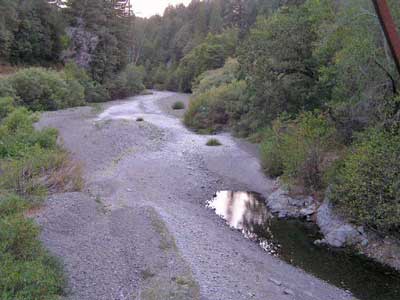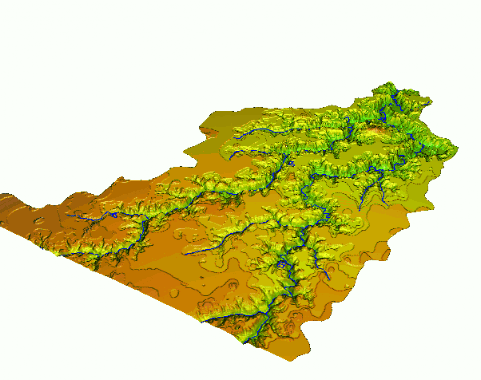![]()
Del Suelo al Cielo: Sobre el Origen de los Insectos Alados
Me encontraba leyendo una noticia sobre el origen de los insectos alados cuando detecté que se hablaba de “excavaciones en el lecho de un río”. Sabiendo sobradamente que el suelo es un recurso natural que se les atraganta a los periodistas y colegas de otras disciplinas (algún día “morderán el polvo”) me puse yo también a “excavar en el ciberespacio”. Y, como era de esperar, me topé con el suelo, en principio del Cretácico y después, retrocediendo en el tiempo, hasta el Devónico. Eso sí, todo el material recopilado es muy difuso en este asunto. Ahora bien, si he entendido correctamente tal galimatías acerca de la filogenia de los artrópodos, y en especial del origen de los insectos alados, sus ancestros parecen resultar ser organismos del suelo. Quede claro que los autores del del hallazgo, del que se hace eco la nota de prensa que bordamos de hoy, reconocen que da lugar a postular una hipótesis (¡aleluya!: parece que son unos chicos responsables), no una teoría científica incuestionable. Pero todo ello no debiera extrañarnos. Por lo que se sabe hasta le fecha, la invasión de la tierra emergida por los organismos oceánicos acaeció fundamentalmente (que no siempre) vía subacuática, al ascender la vida por las redes fluviales, adaptándose al agua dulce. De este modo, llegaron sumergidos a los confines más insospechados de los continentes, utilizando las arterias de Gaia como autopistas.

Lecho de un Río. Fuente: Walalariver
Los suelos, sumergidos o no, ofrecen un refugio a los organismos acuáticos. Debemos recordar que, aun hoy en día todos los microorganismos y pequeños invertebrados (microfauna) siguen habitando en el medio acuoso (nemátodos, rotíferos, tardígrados, etc.). Se trata de micro-hábitats que se ubican entre los poros y rodeando los agregados del suelo. Y tal hecho acaece aunque el medio edáfico, aparentemente, nos parezca seco. Posiblemente, a lo largo de eones, sequías (cambios climáticos) que inducían a que muchas cuencas de drenaje a penas acarrearan agua, generaron el estreses ambientales que promovieron mutaciones. Estas últimas, a la postre, dieron lugar a organismos adaptados a la vida aérea, algunos de los cuales terminaron por salir “volando”, incluyendo a esos malditos mosquitos. Los cauces fluviales, por alcanzar cualquier lugar de la superficie emergida de la biosfera, toparon con todo tipo de hábitats y condiciones ambientales, dando lugar a que los organismos acuáticos tuvieran, tarde o temprano que enfrentarse a cualquier vaivén ambiental. Valga este post tan solo como un botón de muestra más de la importancia de los organismos edáficos (mayoritariamente acuáticos) en el desenfreno posterior de la diversificación de la vida terrestre. Soslayo traducir el material que muestro abajo, por cuanto no se me antoja lo suficientemente interesante para los intereses de esta bitácora. También debo reconocer que me pierdo en un tema que apenas conozco. Basta con buscar en los textos que a continuación os expongo ese extraño vocablo suahileño “soil” que en cristiano corresponde a la palabra suelo.

Cuencas de drenaje: arterias de Gaia que alcanzan los lugares más inhóspitos de los continentes
Juan José Ibáñez
Nuevas pistas sobre la evolución de los insectos
El grupo de trabajo dirigido por el Arnold H. Staniczek y Günter Bechly, ambos expertos en insectos, determinó que estos fósiles representan parientes que se extinguieron en la modernidad ¿¿??.
FUENTE | La Razón digit@l 20/07/2011
Debido al descubrimiento de ejemplares adultos con alas, y larvas en excelente estado de conservación, los científicos fueron capaces de aclarar la posición filogenética de estos animales y se presentó una nueva hipótesis sobre las relaciones de los insectos alados.
Equipado con venación alar de una forma efímera, el pecho y las alas de una libélula, y las patas de una mantis religiosa, estos insectos alados parecen un mosaico de diversos animales.
Las larvas, sin embargo, son una reminiscencia de camarones de agua dulce. Su estilo de vida resultó ser un gran enigma: el modo de inserción y algunos de sus personajes sugieren claramente un hábitat fluvial. Su singular anatomía indica, además, que estos animales eran depredadores de emboscada que viven en un parte excavada en el lecho del río.
Tras estos descubrimientos, los científicos suponen que las alas se originaron a partir de las placas torácicas posteriores, mientras que los genes de las piernas fueron reclutados para el control del desarrollo.
En general, el excitante descubrimiento de Coxoplectoptera contribuye a una mejor comprensión de la evolución de los insectos
Información en otros medios de comunicación
Científicos alemanes descubren un nuevo orden de insectos del Cretácico Inferior de América del Sur. Los fósiles fueron nombrados Coxoplectoptera por sus descubridores y sus resultados fueron publicados en una edición especial sobre insectos.
Los científicos analizan en su artículo fósiles que se encontraron en finos sedimentos de Brasil de hace unos 120 millones de años unas larvas y ejemplares con alas que estaban muy bien conservados. Podrían ser parientes de especies que posteriormente se extinguieron, por lo que hoy no tendrían descendientes.
Capítulo de un Nuevo Libro de la Editorial Cambridge University Press
Apterygota: primarily wingless insects
These announcements coincided with the commencement of a major increase in the commercial extraction of the Crato limestones or so-called pedra de larje. Today, specimens of Dastilbe can be purchased in fossil shops around the world or on the Internet, and the number of scientific papers describing Crato fossils is in the hundreds. From an initial faunal list of a single fish and an unnamed mayfly larva in the middle of the twentieth century, the faunal and floral list today includes over 100 insect species, nine species of fish and nearly a dozen arachnids. Turtles, lizards and even a bird are known, but among the vertebrates the formation is gaining prominence for the diversity and spectacular preservation of its pterosaurs. The Crato Formation has the most diverse fossil assemblage for any non-marine Cretaceous locality in Gondwana, and perhaps Laurasia too. Museum collections around the world are full of new species of Crato insects, plants and even pterosaurs just waiting to be described. This book brings together the various components of the palaeobiota and attempts to describe the ancient environments represented by the formation. It is one of the clearest windows yet into the Mesozoic, and although its edges may still be misty, a picture of a Cretaceous low-latitude environment is becoming much, much clearer.
11.2 Apterygota: primarily wingless insects
Arnold H. Staniczek and Gunter Bechly
There are several small-taxa at the base of the Hexapoda lacking wings that formerly were referred to as ‘Apterygota’, until Hennig (1953) recognized its paraphyly with respect to the winged insects, the Pterygota. Usually five Recent higher taxa are recognized among apterygotes: Collembola (springtails), Protura, Diplura, Archaeognatha (bristletails) and Zygentoma (silverfish and firebrats), the former three often united as the Entognatha, as their mouthparts are enclosed within a gnathal pouch. Recently it has been proposed that Diplura are more closely related to the insects than to Protura and Collembola (Bitsch and Bitsch, 2000). It is generally accepted that Archaeognatha and Zygentoma have closer phylogenetic affinities to the Pterygota than to the entognathous taxa. All of these taxa, however, share a number of plesiomorphic characters such as the retention of abdominal leglets and moulting even in the adult stage. In the Crato Formation, so far only one species each of Diplura (two specimens) and Zygentoma (two specimens) have been discovered (Figure 11.1; Plates 7a and b). The other orders are certainly to be expected in the Mesozoic of South America as well, but probably have a very low preservation potential due to a combination of their delicate anatomy, tiny size and cryptic lifestyle as soil-dwelling organisms.
Order Diplura: diplurans
Diplura is a globally distributed taxon comprising about 850 recent species. They are generally classified into two different lineages, the Campodeomorpha (Rhabdura) and Japygomorpha (Dicellurata), which have a rather different appearance. Campodeomorph diplurans have long slender legs that enable fast movement and high agility, whereas japygomorphs are better adapted for a life within soil interstices. While the campodeomorphs have filiform cerci consisting of many segments, the cerci of japygomorphs are transformed into unsegmented forceps. Both groups, however, are cryptozoic and confined to soil. Campodeiform diplurans are mostly omnivorous or herbivorous animals, which feed on a variety of plant matter, often rotten leaves. The japygomorphs are predominantly predators and feed on other soil-dwelling arthropods such as other entognathous insects, myriapods and mites. They generally catch their prey by grasping it with the abdominal forceps. All diplurans are small and soft-bodied hexapods of whitish colour that generally only reach a body size of a few millimetres, but some japygomorphs may achieve a larger body size, of up to 6 cm. The Campodeomorpha have long filiform antennae with up to 70 segments. As in all primarily apterous hexapods, all antennal segments are equipped with intrinsic muscles. The antennae of japygomorphs are comparably short and stout, and in some they even resemble a telescope with retractable segments. (…) All Recent diplurans lack compound eyes, but the entire body is equipped with a variety of sensory hairs. Their abdomen is composed of 10 segments, the anterior seven bearing paired leglets and often also ventral eversible vesicles that are actively used to absorb water (…)
Most recent authors unite Diplura and Ellipura (Collembola+Protura) in the Entognatha (…) Judging from their phylogenetic position as basal hexapods Diplura must have already originated by the Early Devonian, but unfortunately there are no fossils from this period that could shed light on their early evolution. The enigmatic Testajapyxthomasi from the Upper Carboniferous of Mazon Creek of Illinois (Kukalov´a-Peck, 1987) bears well-developed compound eyes, long maxillary and labial palps, and multi-articulated abdominal leglets. Its abdomen bears the typical forceps of the Rhabdura (…)
Referencia de La Publicación
STANICZEK, A. & BECHLY, G. & GODUNKO, R.J. (2011): Coxoplectoptera, a new fossil order of Palaeoptera (Arthropoda: Insecta), with comments on the phylogeny of the stem group of mayflies (Ephemeroptera). – Insect Systematics & Evolution, 42: 101-138.
Mysterious Fossils Provide New Clues to Insect Evolution
ScienceDaily (July 19, 2011) — Scientists at the Stuttgart Natural History Museum and colleagues have discovered a new insect order from the Lower Cretaceous of South America. The spectacular fossils were named Coxoplectoptera by their discoverers and their findings were published in a special issue on Cretaceous Insects in the scientific journal Insect Systematics & Evolution.
The work group led by Dr. Arnold H. Staniczek and Dr. Günter Bechly, both experts on basal insects, determined that these fossils represent extinct relatives of modern mayflies. Coxoplectoptera, however, significantly differ from both mayflies and all other known insects in anatomy and mode of life. With the discovery of adult winged specimens and excellently preserved larvae, the scientists were able to clarify the phylogenetic position of these animals and presented a new hypothesis regarding the relationships of basal winged insects. Equipped with wing venation of a mayfly, breast and wing shape of a dragonfly, and legs of a praying mantis, these winged insects look like a patchwork of various animals. The peculiar larvae, however, are reminiscent of freshwater shrimps. Their lifestyle turned out to be a major enigma: their mode of embedding and certain other characteristics clearly suggest a fluvial habitat. Their unique anatomy indicates that these animals were ambush predators living partly dug in the river bed.
These animals furthermore provided clues to the long-standing controversial debate of the evolutionary origin of the insect wing. The scientists presume that wings originated from thoracic backplates, while leg genes were recruited for their developmental control.
